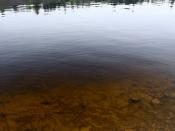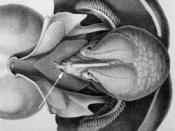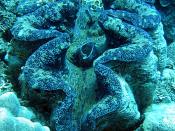~ Classification
The clam's kingdom is Anamalia, Phylum is Mollusk, which includes snails, clams, chitons, slugs, limpets, octopi, and squid, then Bivalvia or Pelecypoda is their class. Next their order is, unionoida, Family is unionoidae.
~ Habitat
Clam is a common name for many species of bivalve mollusks that burrow wholly or partly into sand or mud by means of a hatchet-shaped muscular foot. These creature's habitats vary from salt water, to fresh water, or even land. Because this species does not burrow deeply, it may be obtained by raking the ocean bottom beyond the low-tide mark. It is found buried in the sand between tidemarks along the coast of just about every ocean side. They usually live on either sandy gravel or exposed beaches, When disturbed, it ejects a spurt of water and withdraws to safer depths in the sand. This clam--also called the steamer, or the steamer clam--is obtained by digging in the sand at low tide.
Planktonic larvae dispersed by currents, but adults remain in same burrow for life.
~ Prey & Predators
Most clams feed on phytoplankton, which are microscopic in size. The particles are ingested through the incurrent siphon and are captured by mucus-coated cilia and delivered to the digestive system. Also, they do eat zooplankton and detritus. For predators, mostly crabs and fishes prey on juveniles, but moon snail, birds, and sea stars prey on adults.
~ Digestive System
The food particles that are filtered from the water passing through the ctenidia are carried anteriorly by water currents and guided to the mouth by the labial palps. A short esophagus leads to the irregularly shaped stomach, which is embedded in the greenish digestive gland (1iver). From the stomach, the intestine extends through the pericardial cavity to the rectum, which is located dorsal to...



*glares*
All I can say is this:
You did your research... So thats good.
P.S I didn't see any spelling mistakes...
*Thumbs up*
1 out of 1 people found this comment useful.